Effect of Hot Rolling on Structure and Mechanical Properties of Mg–Y–Zn–Mn Alloys
Abstract
1. Introduction
2. Materials and Methods
2.1. Materials
2.2. Materials
2.3. Microhardness Measurement
2.4. Tensile Test
2.5. Structural Studies
3. Results and Discussion
3.1. Microstructure Analysis
3.1.1. Microstructure of the Alloys in As-Cast and Heat Treated States
3.1.2. Microstructure of the Alloys after Rolling
3.2. Mechanical Properties
3.2.1. Microhardness Measurement
3.2.2. Tensile Tests
4. Conclusions
Author Contributions
Funding
Institutional Review Board Statement
Informed Consent Statement
Data Availability Statement
Acknowledgments
Conflicts of Interest
References
- Gareb, B.; Van Bakelen, N.B.; Vissink, A.; Bos, R.R.M.; Van Minnen, B. Titanium or Biodegradable Osteosynthesis in Maxillofacial Surgery? In Vitro and In Vivo Performances. Polymers 2022, 14, 2782. [Google Scholar] [CrossRef] [PubMed]
- Vujović, S.; Desnica, J.; Stanišić, D.; Ognjanović, I.; Stevanovic, M.; Rosic, G. Applications of Biodegradable Magnesium-Based Materials in Reconstructive Oral and Maxillofacial Surgery: A Review. Molecules 2022, 27, 5529. [Google Scholar] [CrossRef] [PubMed]
- Kraus, T.; Fischerauer, S.F.; Hänzi, A.C.; Uggowitzer, P.J.; Löffler, J.F.; Weinberg, A.M. Magnesium alloys for temporary implants in osteosynthesis: In vivo studies of their degradation and interaction with bone. Acta Biomater. 2012, 8, 1230–1238. [Google Scholar] [CrossRef] [PubMed]
- Staiger, M.P.; Pietak, A.M.; Huadmai, J.; Dias, G. Magnesium and its alloys as orthopedic biomaterials: A review. Biomaterials 2006, 27, 1728–1734. [Google Scholar] [CrossRef]
- Gu, X.-N.; Li, S.-S.; Li, X.-M.; Fan, Y.-B. Magnesium based degradable biomaterials: A review. Front. Mater. Sci. 2014, 8, 200–218. [Google Scholar] [CrossRef]
- Tran, N.T.; Kim, Y.-K.; Kim, S.-Y.; Lee, M.-H.; Lee, K.-B. Comparative Osteogenesis and Degradation Behavior of Magnesium Implant in Epiphysis and Diaphysis of the Long Bone in the Rat Model. Materials 2022, 15, 5630. [Google Scholar] [CrossRef]
- Gu, X.-N.; Zheng, Y.-F. A review on magnesium alloys as biodegradable materials. Front. Mater. Sci. China 2010, 4, 111–115. [Google Scholar] [CrossRef]
- Nguyen, A.; Kunert, M.; Hort, N.; Schrader, C.; Weisser, J.; Schmidt, J. Cytotoxicity of the Ga-containing coatings on biodegradable magnesium alloys. Surf. Innov. 2015, 3, 10–19. [Google Scholar] [CrossRef]
- Rider, P.; Kačarević, Ž.P.; Elad, A.; Rothamel, D.; Sauer, G.; Bornert, F.; Windisch, P.; Hangyási, D.; Molnar, B.; Hesse, B.; et al. Biodegradation of a Magnesium Alloy Fixation Screw Used in a Guided Bone Regeneration Model in Beagle Dogs. Materials 2022, 15, 4111. [Google Scholar] [CrossRef]
- Delsmann, M.M.; Stürznickel, J.; Kertai, M.; Stücker, R.; Rolvien, T.; Rupprecht, M. Radiolucent zones of biodegradable magnesium-based screws in children and adolescents—A radiographic analysis. Arch. Orthop. Trauma Surg. 2022. [Google Scholar] [CrossRef]
- Chen, Y.; Xu, Z.; Smith, C.; Sankar, J. Recent advances on the development of magnesium alloys for biodegradable implants. Acta Biomater. 2014, 10, 4561–4573. [Google Scholar] [CrossRef] [PubMed]
- Sun, Y.; Zhang, B.; Wang, Y.; Geng, L.; Jiao, X. Preparation and characterization of a new biomedical Mg–Zn–Ca alloy. Mater. Des. 2012, 34, 58–64. [Google Scholar] [CrossRef]
- Zhang, B.; Wang, Y.; Geng, L.; Lu, C. Effects of calcium on texture and mechanical properties of hot-extruded Mg–Zn–Ca alloys. Mater. Sci. Eng. A 2012, 539, 56–60. [Google Scholar] [CrossRef]
- Tong, L.B.; Zheng, M.Y.; Hu, X.S.; Wu, K.; Xu, S.W.; Kamado, S.; Kojima, Y. Influence of ECAP routes on microstructure and mechanical properties of Mg–Zn–Ca alloy. Mater. Sci. Eng. A 2010, 527, 4250–4256. [Google Scholar] [CrossRef]
- Tong, L.B.; Zheng, M.Y.; Xu, S.W.; Kamado, S.; Du, Y.Z.; Hu, X.S.; Wu, K.; Gan, W.M.; Brokmeier, H.G.; Wang, G.J.; et al. Effect of Mn addition on microstructure, texture and mechanical properties of Mg–Zn–Ca alloy. Mater. Sci. Eng. A 2011, 528, 3741–3747. [Google Scholar] [CrossRef]
- Geng, L.; Zhang, B.P.; Li, A.B.; Dong, C.C. Microstructure and mechanical properties of Mg–4.0Zn–0.5Ca alloy. Mater. Lett. 2009, 63, 557–559. [Google Scholar] [CrossRef]
- Bian, D.; Zhou, W.; Deng, J.; Liu, Y.; Li, W.; Chu, X.; Xiu, P.; Cai, H.; Kou, Y.; Jiang, B.; et al. Development of magnesium-based biodegradable metals with dietary trace element germanium as orthopaedic implant applications. Acta Biomater. 2017, 64, 421–436. [Google Scholar] [CrossRef]
- Niu, J.; Yuan, G.; Liao, Y.; Mao, L.; Zhang, J.; Wang, Y.; Huang, F.; Jiang, Y.; He, Y.; Ding, W. Enhanced biocorrosion resistance and biocompatibility of degradable Mg–Nd–Zn–Zr alloy by brushite coating. Mater. Sci. Eng. C 2013, 33, 4833–4841. [Google Scholar] [CrossRef]
- Naujokat, H.; Seitz, J.-M.; Açil, Y.; Damm, T.; Möller, I.; Gülses, A.; Wiltfang, J. Osteosynthesis of a cranio-osteoplasty with a biodegradable magnesium plate system in miniature pigs. Acta Biomater. 2017, 62, 434–445. [Google Scholar] [CrossRef]
- Byun, S.-H.; Lim, H.-K.; Cheon, K.-H.; Lee, S.-M.; Kim, H.-E.; Lee, J.-H. Biodegradable magnesium alloy (WE43) in bone-fixation plate and screw. J. Biomed. Mater. Res. Part B Appl. Biomater. 2020, 108, 2505–2512. [Google Scholar] [CrossRef]
- Lee, J.Y.; Kim, D.H.; Lim, H. Effects of Zn/Y ratio on microstructure and mechanical properties of Mg-Zn-Y alloys. Mater. Lett. 2005, 59, 3801–3805. [Google Scholar] [CrossRef]
- Okayasu, M.; Takeuchi, S.; Matsushita, M.; Tada, N.; Yamasaki, M.; Kawamura, Y. Mechanical properties and failure characteristics of cast and extruded Mg97Y2Zn1 alloys with LPSO phase. Mater. Sci. Eng. A 2016, 652, 14–29. [Google Scholar] [CrossRef]
- Singh, A.; Osawa, Y.; Somekawa, H.; Mukai, T. Ultra-fine grain size and isotropic very high strength by direct extrusion of chill-cast Mg–Zn–Y alloys containing quasicrystal phase. Scr. Mater. 2011, 64, 661–664. [Google Scholar] [CrossRef]
- Tahreen, N.; Chen, D.L. A Critical Review of Mg-Zn-Y Series Alloys Containing I, W, and LPSO Phases. Adv. Eng. Mater. 2016, 18, 1983–2002. [Google Scholar] [CrossRef]
- Xu, D.K.; Tang, W.N.; Liu, L.; Xu, Y.B.; Han, E.H. Effect of W-phase on the mechanical properties of as-cast Mg–Zn–Y–Zr alloys. J. Alloys Compd. 2008, 461, 248–252. [Google Scholar] [CrossRef]
- Luo, Z.P.; Zhang, S.Q. High-resolution electron microscopy on the X-Mg12ZnY phase in a high strength Mg-Zn-Zr-Y magnesium alloy. J. Mater. Sci. Lett. 2000, 19, 813–815. [Google Scholar] [CrossRef]
- Bazhenov, V.E.; Saidov, S.S.; Tselovalnik, Y.V.; Voropaeva, O.O.; Plisetskaya, I.V.; Tokar, A.A.; Bazlov, A.I.; Bautin, V.A.; Komissarov, A.A.; Koltygin, A.V.; et al. Comparison of castability, mechanical, and corrosion properties of Mg-Zn-Y-Zr alloys containing LPSO and W phases. Trans. Nonferrous Met. Soc. China 2021, 31, 1276–1290. [Google Scholar] [CrossRef]
- Bakhsheshi-Rad, H.R.; Idris, M.H.; Abdul-Kadir, M.R.; Ourdjini, A.; Medraj, M.; Daroonparvar, M.; Hamzah, E. Mechanical and bio-corrosion properties of quaternary Mg–Ca–Mn–Zn alloys compared with binary Mg–Ca alloys. Mater. Des. 2014, 53, 283–292. [Google Scholar] [CrossRef]
- Ibrahim, H.; Moghaddam, N.; Elahinia, M. Mechanical and In Vitro Corrosion Properties of a Heat-Treated Mg-Zn-Ca-Mn Alloy as a Potential Bioresorbable Material. Adv. Metall. Mater. Eng. 2017, 1, 1–7. [Google Scholar] [CrossRef]
- Yandong, Y.; Shuzhen, K.; Teng, P.; Jie, L.; Caixia, L. Effects of Mn Addition on the Microstructure and Mechanical Properties of As-cast and Heat-Treated Mg-Zn-Ca Bio-magnesium Alloy. Metallogr. Microstruct. Anal. 2015, 4, 381–391. [Google Scholar] [CrossRef]
- She, J.; Pan, F.S.; Guo, W.; Tang, A.T.; Gao, Z.Y.; Luo, S.Q.; Song, K.; Yu, Z.W.; Rashad, M. Effect of high Mn content on development of ultra-fine grain extruded magnesium alloy. Mater. Des. 2016, 90, 7–12. [Google Scholar] [CrossRef]
- Cho, D.H.; Lee, B.W.; Park, J.Y.; Cho, K.M.; Park, I.M. Effect of Mn addition on corrosion properties of biodegradable Mg-4Zn-0.5Ca-xMn alloys. J. Alloys Compd. 2017, 695, 1166–1174. [Google Scholar] [CrossRef]
- Lu, R.; Jiao, K.; Zhao, Y.; Li, K.; Yao, K.; Hou, H. Influence of Long-Period-Stacking Ordered Structure on the Damping Capacities and Mechanical Properties of Mg-Zn-Y-Mn As-Cast Alloys. Materials 2020, 13, 4654. [Google Scholar] [CrossRef] [PubMed]
- Li, D.; Zhang, J.; Que, Z.; Xu, C.; Niu, X. Effects of Mn on the microstructure and mechanical properties of long period stacking ordered Mg95Zn2.5Y2.5 alloy. Mater. Lett. 2013, 109, 46–50. [Google Scholar] [CrossRef]
- Qi, F.; Zhang, D.; Zhang, X.; Xu, X. Effects of Mn addition and X-phase on the microstructure and mechanical properties of high-strength Mg–Zn–Y–Mn alloys. Mater. Sci. Eng. A 2014, 593, 70–78. [Google Scholar] [CrossRef]
- Doherty, R.D.; Hughes, D.A.; Humphreys, F.J.; Jonas, J.J.; Juul Jensen, D.; Kassner, M.E.; King, W.E.; McNelley, T.R.; McQueen, H.J.; Rollett, A.D. Current issues in recrystallization: A review. Mater. Sci. Eng. A 1997, 238, 219–274. [Google Scholar] [CrossRef]
- Sakai, T.; Belyakov, A.; Kaibyshev, R.; Miura, H.; Jonas, J.J. Dynamic and post-dynamic recrystallization under hot, cold and severe plastic deformation conditions. Prog. Mater. Sci. 2014, 60, 130–207. [Google Scholar] [CrossRef]
- He, Y.-B.; Pan, Q.-L.; Chen, Q.; Zhang, Z.-Y.; Liu, X.-Y.; Li, W.-B. Modeling of strain hardening and dynamic recrystallization of ZK60 magnesium alloy during hot deformation. Trans. Nonferrous Met. Soc. China 2012, 22, 246–254. [Google Scholar] [CrossRef]
- Tong, L.B.; Li, X.H.; Zhang, H.J. Effect of long period stacking ordered phase on the microstructure, texture and mechanical properties of extruded Mg–Y–Zn alloy. Mater. Sci. Eng. A 2013, 563, 177–183. [Google Scholar] [CrossRef]
- Rider, P.; Kačarević, Ž.P.; Elad, A.; Tadic, D.; Rothamel, D.; Sauer, G.; Bornert, F.; Windisch, P.; Hangyási, D.B.; Molnar, B.; et al. Biodegradable magnesium barrier membrane used for guided bone regeneration in dental surgery. Bioact. Mater. 2022, 14, 152–168. [Google Scholar] [CrossRef]
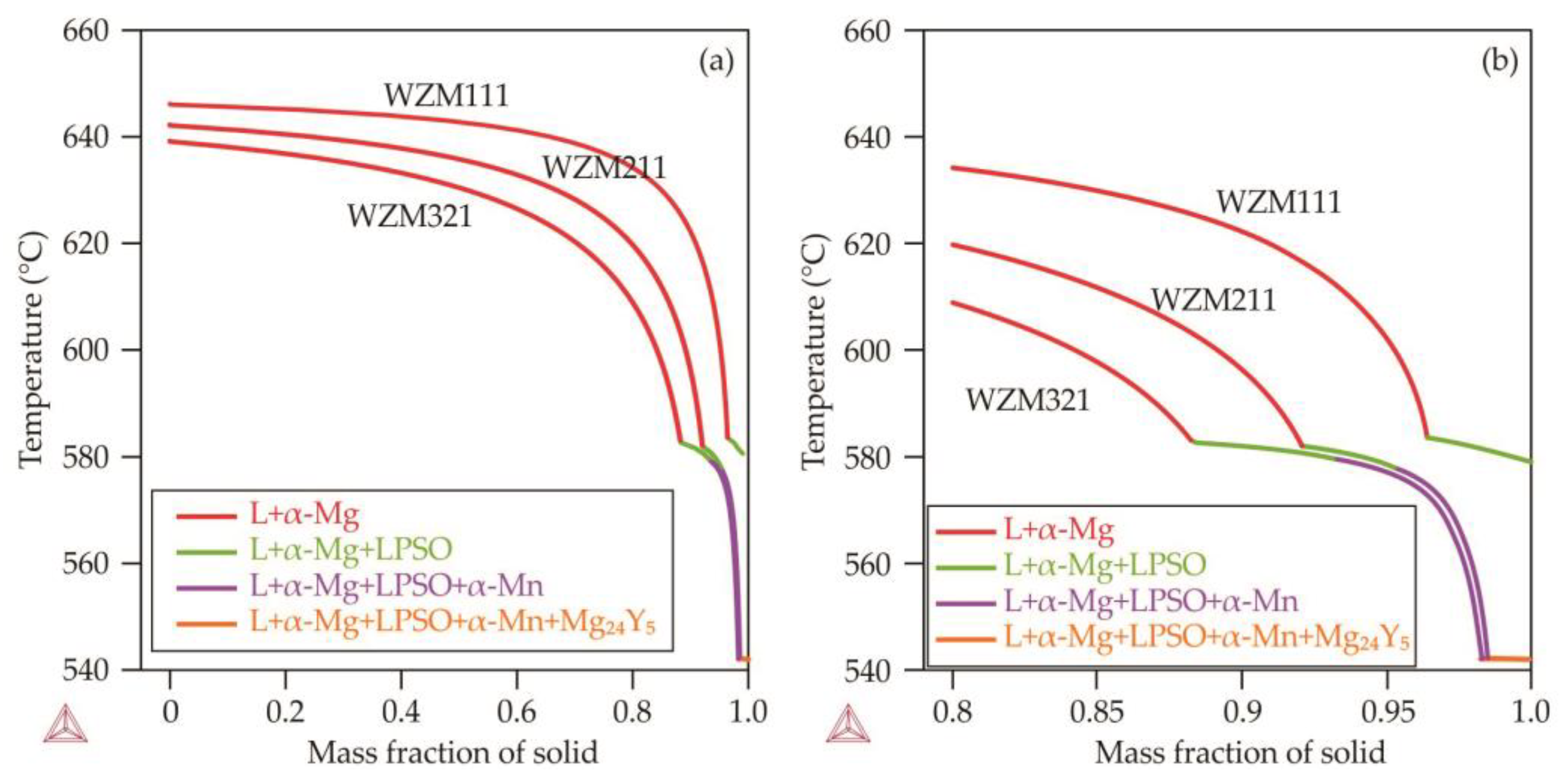
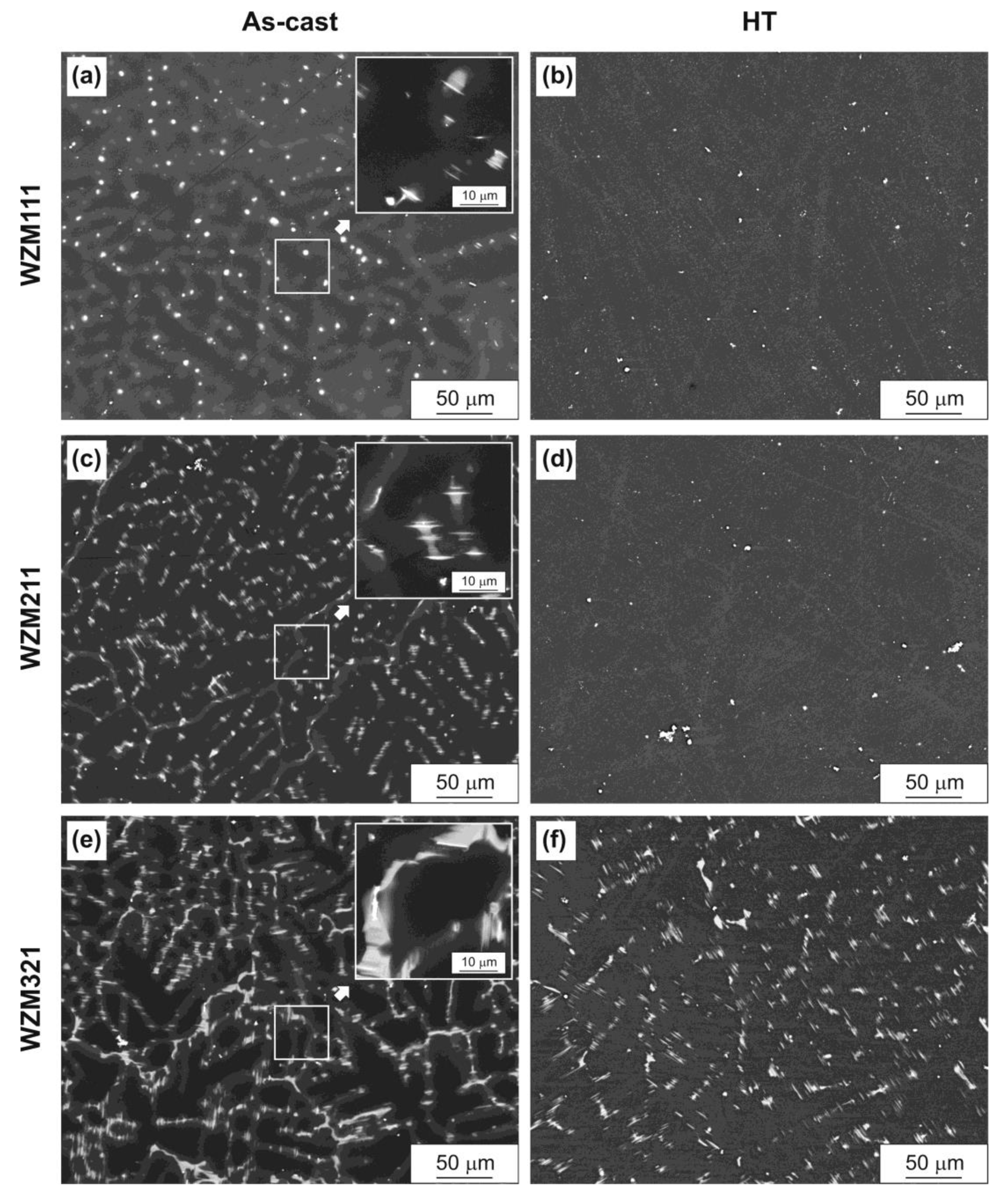





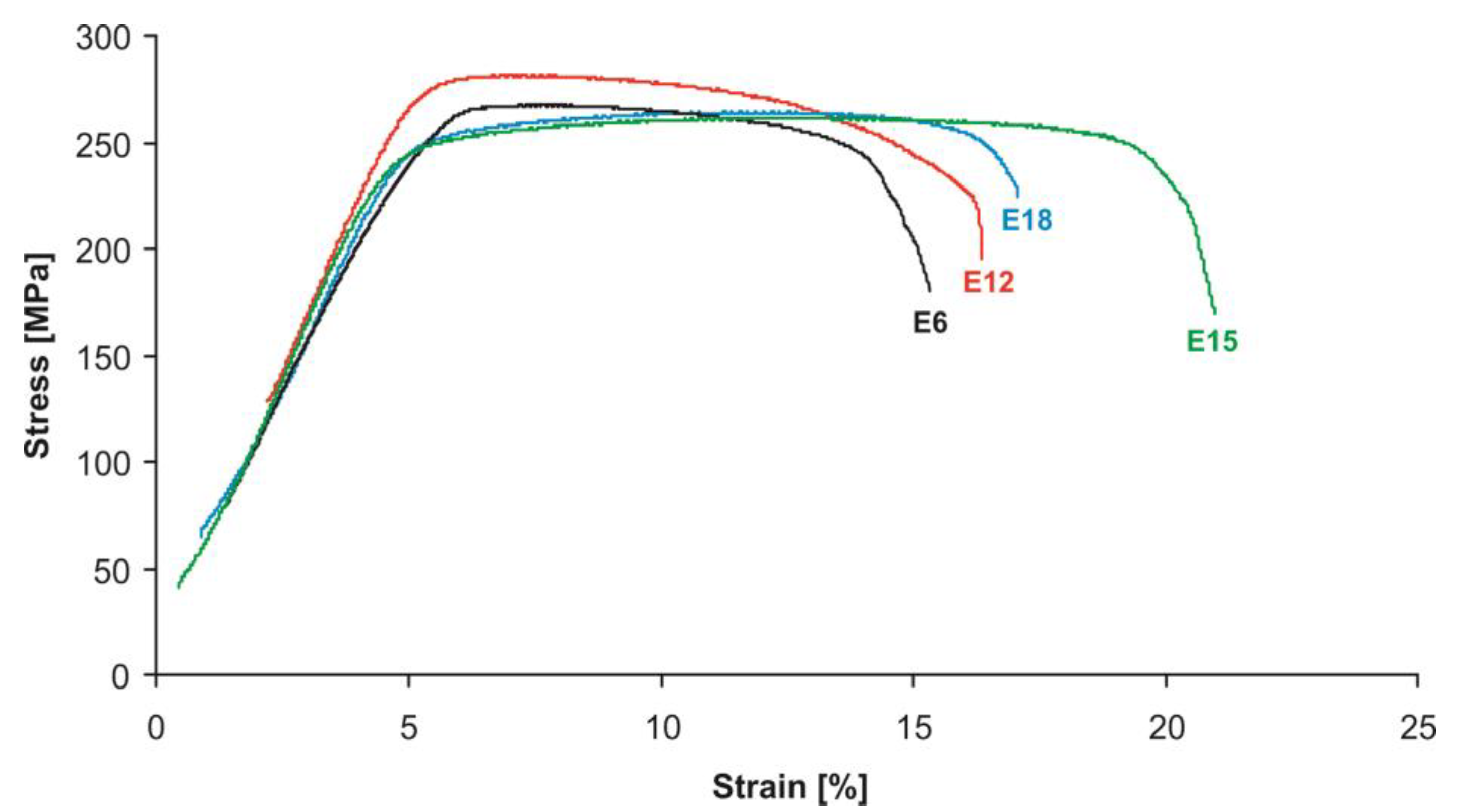
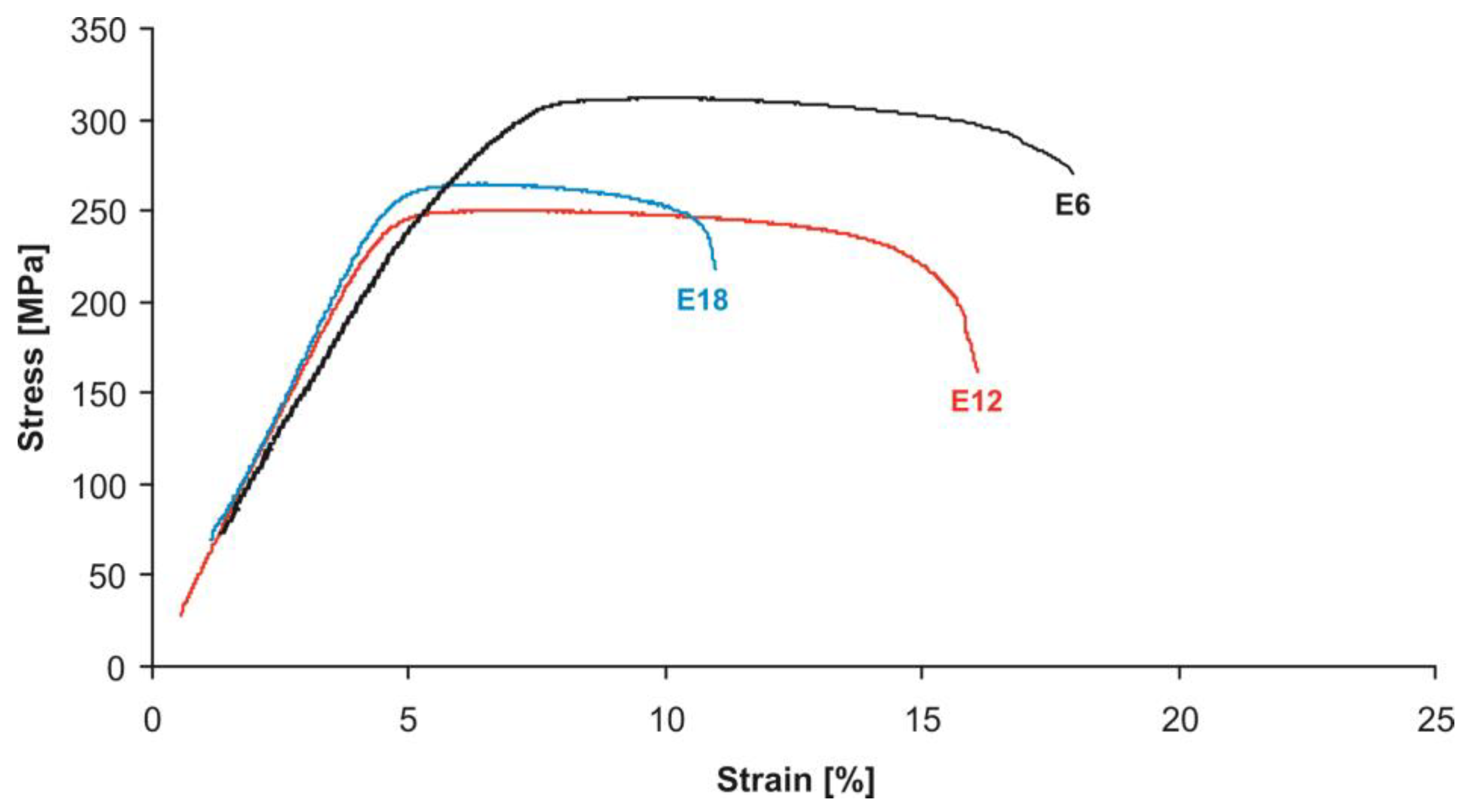


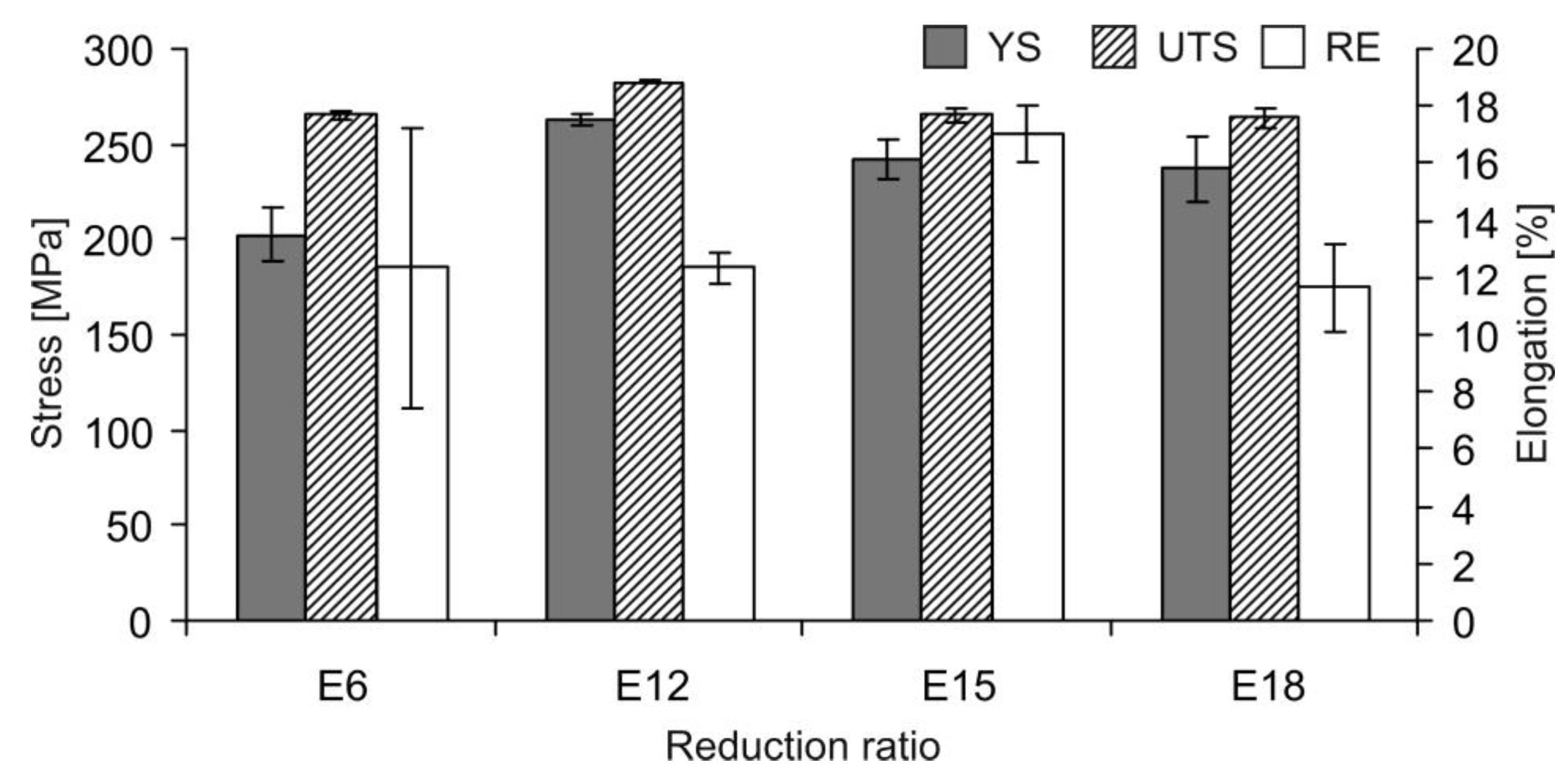

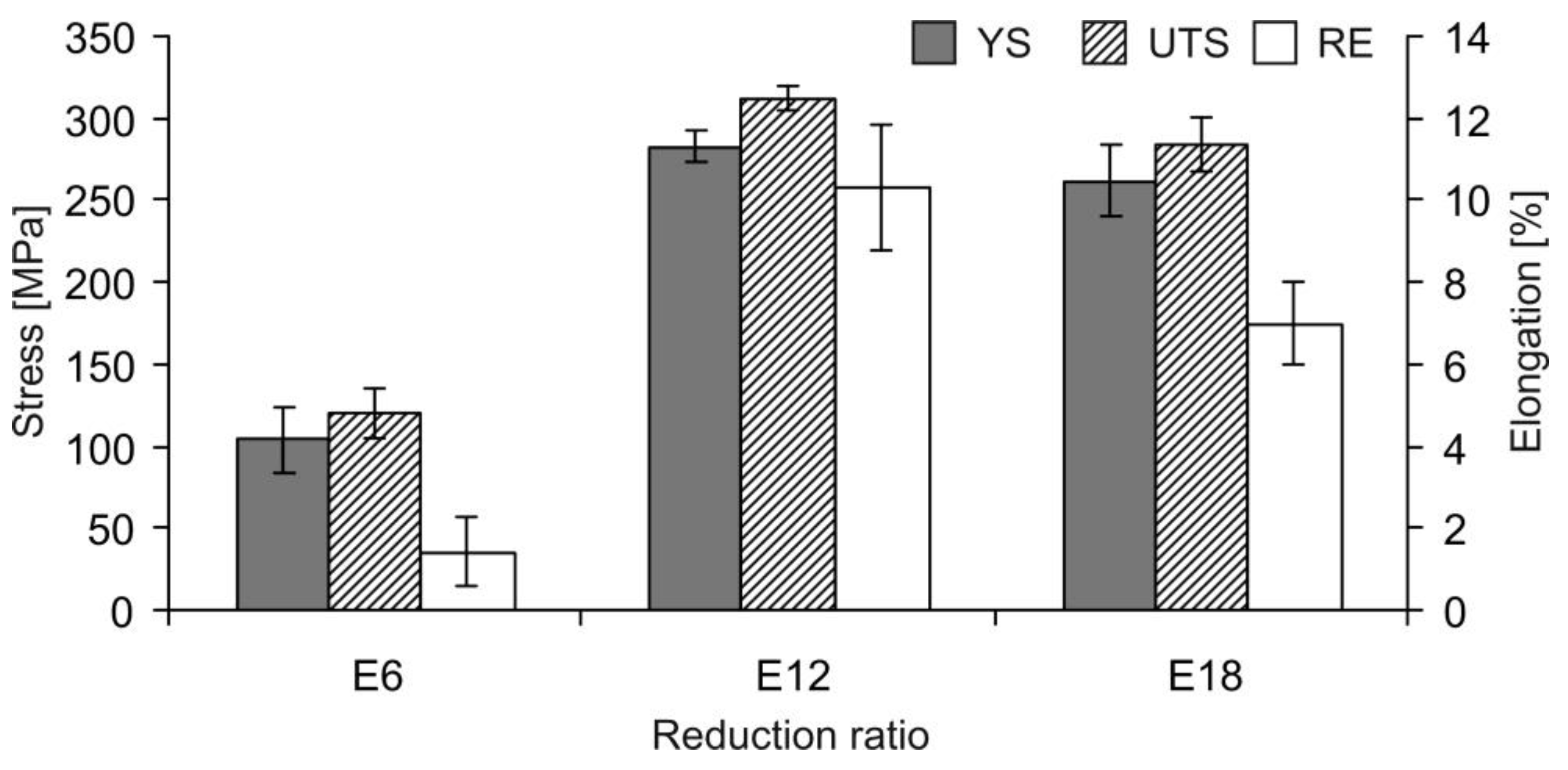
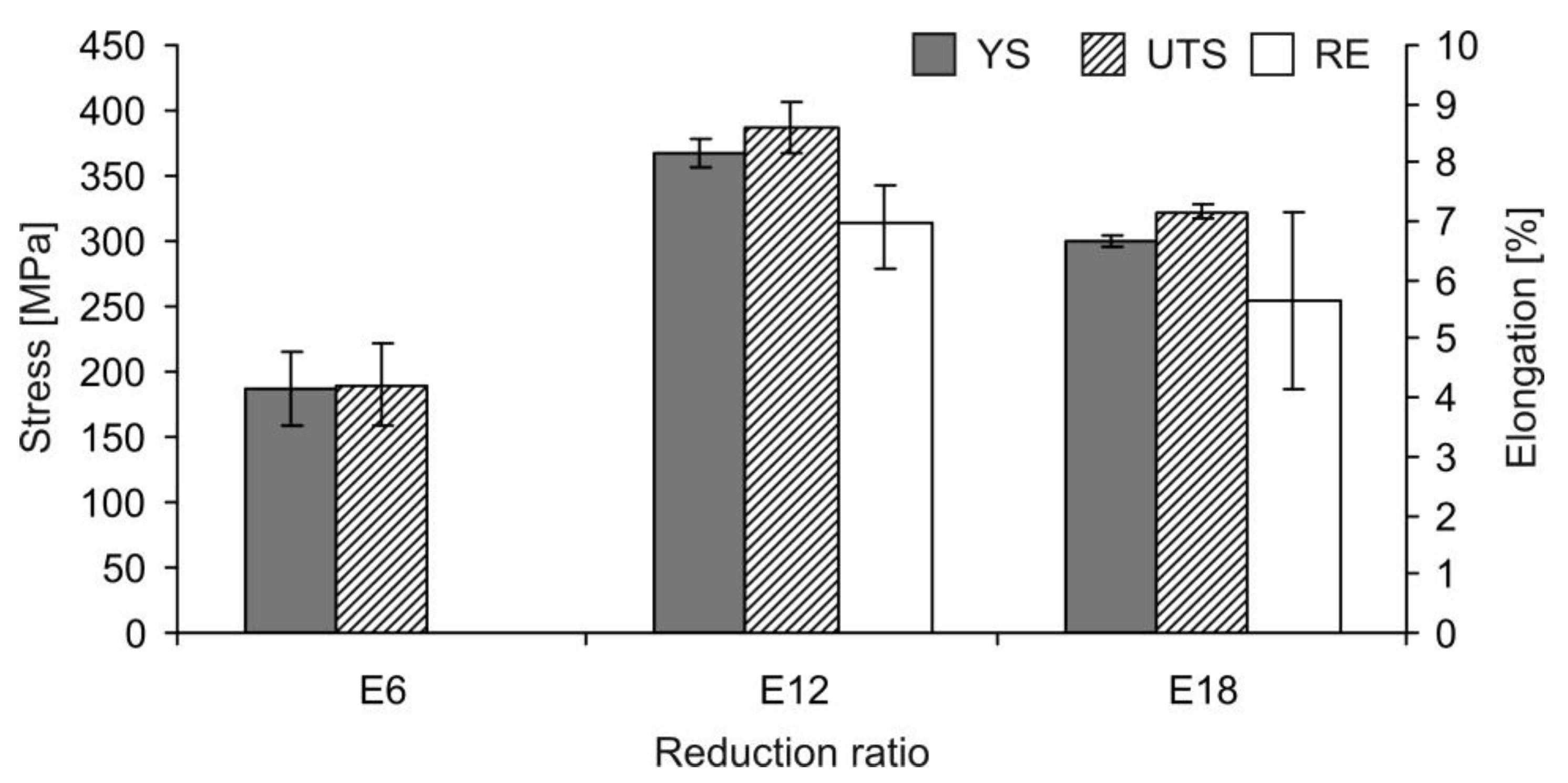
| Alloy Designation | Content of Element (wt.%) | |||
|---|---|---|---|---|
| Mg | Y | Zn | Mn | |
| WZM111 | Bal. | 1.2 | 0.6 | 0.8 |
| WZM211 | Bal. | 2.5 | 1.1 | 0.8 |
| WZM321 | Bal. | 3.4 | 1.7 | 0.8 |
| Sample Designation | Total Reduction Ratio (%) | Final Thickness (mm) |
|---|---|---|
| E3 | 35–37 | 4.42–4.65 |
| E6 | 60–65 | 2.47–2.89 |
| E12 | 88–89 | 0.80–0.83 |
| E15 | 94 | 0.39–0.41 |
| E18 | 96–97 | 0.21–0.25 |
| Alloy | Phase Fraction at Temperature | ||||||||
|---|---|---|---|---|---|---|---|---|---|
| 520 °C | 450 °C | 400 °C | |||||||
| α-Mg | LPSO | α-Mn | α-Mg | LPSO | α-Mn | α-Mg | LPSO | α-Mn | |
| WZM111 | 96.91 | 3.09 | 0 | 95.27 | 4.38 | 0.35 | 94.80 | 4.67 | 0.53 |
| WZM211 | 92.18 | 7.78 | 0.04 | 91.09 | 8.51 | 0.40 | 90.80 | 8.64 | 0.56 |
| WZM321 | 87.64 | 12.30 | 0.06 | 86.68 | 12.92 | 0.40 | 86.42 | 13.02 | 0.56 |
| Reduction Ratio | Rolling Temperature of the Alloy | |||
|---|---|---|---|---|
| 400 °C | 450 °C | 450 °C | 450 °C | |
| WZM111 | WZM211 | WZM321 | ||
| E3 | 77 ± 5 | 72 ± 5 | 92 ± 3 | 93 ± 4 |
| E6 | 76 ± 4 | 75 ± 3 | 81 ± 3 | 93 ± 3 |
| E12 | 80 ± 4 | 76 ± 2 | 86 ± 3 | 91 ± 3 |
| E18 | 73 ± 3 | 77 ± 2 | 82 ± 3 | 91 ± 5 |
| Reduction Ratio | YS (MPa) | UTS (MPa) | RE (%) | UTS/YS |
|---|---|---|---|---|
| E6 | 202.6 ± 14.4 | 265.2 ± 2.1 | 12.3 ± 4.9 | 1.31 |
| E12 | 262.9 ± 2.6 | 282.6 ± 1.1 | 12.3 ± 0.6 | 1.07 |
| E15 | 241.6 ± 10.3 | 265.4 ± 3.3 | 17.0 ± 1.0 | 1.10 |
| E18 | 237.1 ± 16.7 | 263.7 ± 5.3 | 11.7 ± 1.5 | 1.11 |
| Reduction Ratio | YS (MPa) | UTS (MPa) | RE (%) | UTS/YS |
|---|---|---|---|---|
| E6 | 253.7 ± 6.5 | 306.9 ± 5.2 | 13.0 ± 1.0 | 1.21 |
| E12 | 222.1 ± 10.0 | 243.2 ± 7.3 | 13.0 ± 2.6 | 1.09 |
| E18 | 236.0 ± 10.4 | 258.7 ± 5.7 | 7.0 ± 1.7 | 1.10 |
| Reduction Ratio | YS (MPa) | UTS (MPa) | RE (%) | UTS/YS |
|---|---|---|---|---|
| E6 | 103.6 ± 20.1 | 120.6 ± 15.4 | 1.5 ± 1.0 | 1.16 |
| E12 | 282.9 ± 10.4 | 311.3 ± 6.1 | 10.3 ± 1.5 | 1.10 |
| E18 | 261.8 ± 22.2 | 283.0 ± 15.1 | 7.0 ± 1.0 | 1.08 |
| Reduction Ratio | YS (MPa) | UTS (MPa) | RE (%) | UTS/YS |
|---|---|---|---|---|
| E6 | 186.5 ± 28.3 | 189.5 ± 31.7 | 0 | 1.02 |
| E12 | 367.5 ± 11.5 | 386.7 ± 19.3 | 7.0 ± 1.4 | 1.05 |
| E18 | 300.4 ± 4.4 | 322.2 ± 5.8 | 5.7 ± 1.5 | 1.07 |
Disclaimer/Publisher’s Note: The statements, opinions and data contained in all publications are solely those of the individual author(s) and contributor(s) and not of MDPI and/or the editor(s). MDPI and/or the editor(s) disclaim responsibility for any injury to people or property resulting from any ideas, methods, instructions or products referred to in the content. |
© 2023 by the authors. Licensee MDPI, Basel, Switzerland. This article is an open access article distributed under the terms and conditions of the Creative Commons Attribution (CC BY) license (https://creativecommons.org/licenses/by/4.0/).
Share and Cite
Rogachev, S.O.; Bazhenov, V.E.; Komissarov, A.A.; Li, A.V.; Ten, D.V.; Yushchuk, V.V.; Drobyshev, A.Y.; Shin, K.S. Effect of Hot Rolling on Structure and Mechanical Properties of Mg–Y–Zn–Mn Alloys. Metals 2023, 13, 223. https://doi.org/10.3390/met13020223
Rogachev SO, Bazhenov VE, Komissarov AA, Li AV, Ten DV, Yushchuk VV, Drobyshev AY, Shin KS. Effect of Hot Rolling on Structure and Mechanical Properties of Mg–Y–Zn–Mn Alloys. Metals. 2023; 13(2):223. https://doi.org/10.3390/met13020223
Chicago/Turabian StyleRogachev, Stanislav O., Viacheslav E. Bazhenov, Alexander A. Komissarov, Anna V. Li, Denis V. Ten, Viacheslav V. Yushchuk, Alexey Yu. Drobyshev, and Kwang Seon Shin. 2023. "Effect of Hot Rolling on Structure and Mechanical Properties of Mg–Y–Zn–Mn Alloys" Metals 13, no. 2: 223. https://doi.org/10.3390/met13020223
APA StyleRogachev, S. O., Bazhenov, V. E., Komissarov, A. A., Li, A. V., Ten, D. V., Yushchuk, V. V., Drobyshev, A. Y., & Shin, K. S. (2023). Effect of Hot Rolling on Structure and Mechanical Properties of Mg–Y–Zn–Mn Alloys. Metals, 13(2), 223. https://doi.org/10.3390/met13020223







